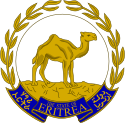Eritrean Liberation Front
This article needs additional citations for verification. (December 2012) |
| Eritrean Liberation Front | |
|---|---|
| Tigrinya: ተጋደሎ ሓርነት ኤርትራ Arabic: جبهة التحرير الإريترية Italian: Fronte di Liberazione Eritreo | |
 Flag of the ELF, also UN given Flag of Eritrea (1952-1962) | |
| Leaders | Idris Mohammed Adem (1961–1975) Ahmed Mohammed Nasser (1975–1982) Abdella Idris (1982–2011) Hussein Kelifah (2011–present) |
| Dates of operation | 1961–present |
| Headquarters | Khartoum, Sudan |
| Active regions | Ethiopia (1961–1991), Eritrea (1991–present) |
| Ideology | Eritrean nationalism Marxism-Leninism (1971–1982) Social conservatism (1982–present) |
| Allies | Eritrean People's Liberation Front (1970–1972, 1974–1980) Cuba (until 1975) Syria Iraq Saudi Arabia Sudan Somalia |
| Opponents | Eritrean People's Liberation Front (1972–1974, 1980–1994) Cuba (1975–1989) Derg Workers' Party of Ethiopia People's Democratic Republic of Ethiopia Tigrayan People's Liberation Front Federal Democratic Republic of Ethiopia |
| Battles and wars | Ethiopian Civil War Eritrean War of Independence Eritrean Civil Wars |
 |
|---|
| Constitution (not enforced) |
| Elections |
|
The Eritrean Liberation Front (ELF) (Tigrinya: ተጋደሎ ሓርነት ኤርትራ; Arabic: جبهة التحرير الإريترية; Italian: Fronte di Liberazione Eritreo), informally known as Jebha, was the main independence movement in Eritrea which sought Eritrea's independence from Ethiopia during the 1960s and the early 1970s.
History[]
In the late 1950s, an unorganized political movement seeking independence was secretly active as small cells. And in July 1960, the ELF was openly established in Cairo by Idris Muhammad Adam and other Eritrean intellectuals and students. In 1961 Hamid Idris Awate formed the armed wing of the ELF and declared the armed struggle for independence. Led by Awate, the ELF came into violent conflict with the government on September 1, 1961, using guerrilla war tactics to continue the struggle. Though the movement posed great problems for the Ethiopian government and army, it was also facing internal political conflicts in the very late 1960s. In the 1970s, a group of its members split the movement and formed the Eritrean People's Liberation Front, a more left-wing rebel movement. By the 1980s, the People's Liberation Front had replaced the original Eritrean Liberation Front as the main rebel group. Following the expulsion of the ELF from Eritrean land, the organization split into three groups: the , led by Ahmed Nasser, the , which eventually united in 1987 with the Eritrean People's Liberation Front, and the remaining faction led by retained the original name. When Eritrea did gain independence in the early 1990s, the People's Liberation Front changed into the People's Front for Democracy and Justice with the addition of former ELF members while the balance became a small rebel group in the nether reaches of Sudan.
Twenty-first century[]
As of 2006, the ELF is a member of the umbrella opposition alliance in Eritrea, the .[1] They were receiving military support from Ethiopia and from the interim government of Somalia based at Baidoa around 2006.[2]
Groups that are splinters of the ELF[]
The was organized around Osman Saleh Sabbe, and Isaias Afewerki. Another split affected within the organization with the emergence of Eritrean People's Liberation Front in 1970. The 1982 led to a split between the Abdellah Idris faction and Ahmed Mohammed Nasser's . Ahmed's group was then affected by another split with the creation of around Ibrahim Toteel and Zemheret Yohannes.
Organizations affiliated with the Eritrean Liberation Front[]
- General Union of Eritrean Students
- General Union of Eritrean Workers
- General Union of Eritrean Women
- General Union of Eritrean Peasants
- Eritrean Red Cross and Red Crescent Society
References[]
- ^ "An Interview With Dr. Yohannes Zeremariam". Awate. Archived from the original on 2006-06-29. Retrieved 2006-09-15.
- ^ "Ethiopia troops head for Baidoa". BBC News. 20 August 2006. Retrieved 2006-09-15.
External links[]
- Eritrean nationalism
- Eritrean War of Independence
- Factions of the Ethiopian Civil War
- Guerrilla organizations
- National liberation movements in Africa
- Rebel groups in Eritrea
- Rebel groups in Ethiopia
- Organizations established in 1960